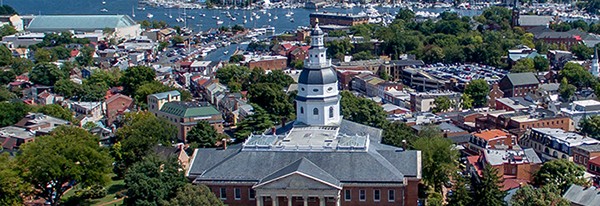Freedom Bound, developed by Historic Annapolis in 2013, will be on display at the Banneker-Douglass Museum in Annapolis beginning September 18, 2021.
Candis, an enslaved black woman, ran away from Frederick County, Maryland in October 1798. She reportedly escaped with William Stewart, a free black carpenter who carried passes for himself and Candis, who was posing as his wife Elizabeth. By this time, Baltimore and Pennsylvania were appealing destinations for runaway slaves, and fugitives might find help from free blacks like the Stewarts or sympathetic whites. We don't know if Candis managed to elude capture or if she was caught and returned to slavery.
Isabella Pierce, an English convict servant woman, ran away from a Virginia plantation along the Potomac River in March 1745. Pierce was an identity thief who stole the indenture papers of another servant and tried to pass herself off as Bridget Castilo. By offering rewards for her return in both the Annapolis and Williamsburg newspapers, Isabella Pierce's master tried to cast as wide a search net as possible, but she may have had too much of a head start to be found. Working against her was the fact that she walked with a noticeable limp and had large scars on her right ankle, possibly the result of having been shackled in an English prison or on the ship that brought her to America.
Jack, an enslaved African man about 30 years old, ran away from a Potomac River plantation in August 1761. Jack's master was a prominent Virginia planter and military officer named George Washington. Washington's newspaper ads for Jack and the three other enslaved men who ran with him describe the African tribal body marks, filed teeth, and speech patterns that would have helped searchers identify the runaways. All four men were eventually captured, and Washington separated them among his Mount Vernon farms so they couldn't plan another escape together.
James Watkins, an enslaved black man originally named Sam Berry, ran away from a plantation near Cockeysville, Maryland in May 1844 when he was in his early 20s. Watkins travelled 350 miles to freedom in Connecticut. We don't have a surviving newspaper ad announcing his escape. Instead, Watkins proudly announced to the world that he was a fugitive from bondage through the pages of his books and the words of his anti-slavery lectures delivered to audiences in England. Like fellow Marylanders Frederick Douglass and Harriett Tubman, Watkins spoke up not only for himself but also all those suffering in slavery.
Oliver Stephens, an Irish indentured servant aged about 23, ran away from Annapolis in July 1771. The young musician worked at Mary Howard's Coffee-House on what is now Main Street. Within his first nine months in town, he ran away twice, despite what Mrs. Howard considered to be "mild and even genteel Treatment." A search of Revolutionary War military records turned up a Private Oliver Stephens who might the same man as our runaway servant. Private Stephens enlisted late in the war and received fifty acres of western Maryland land as a reward for his service.
Stephen, an enslaved black man, ran away from Annapolis in December 1728. Charles Carroll's skilled cooper (or barrel maker) escaped just before Christmas, a season when slaves were often given a break from their usual work to visit family and friends. We know from Maryland Gazette notices and court records that Stephen was suspected of stealing a horse, that he was caught on a plantation in Prince George's County, imprisoned in Annapolis, tried, convicted, and sentenced to death. Maryland's governor reprieved Stephen in June 1729, possibly because of his wealthy master's influence.
William "Rolla" Ross, an enslaved young black man about 14 years old, escaped from Annapolis in December 1814. He fled with more than twenty other area slaves and found refuge on HMS Menelaus, a British warship preparing to leave the Chesapeake Bay after the failed attack on Baltimore in the War of 1812. Thanks to depositions submitted in support of Lewis Neth's post-war reparations claim, we know a lot about Rolla Ross's escape and his last face-to-face meeting with his master's son aboard the Menelaus. Thanks to continuing work by Maryland State Archives staff members and information provided by one of Ross's descendants, we also know about his long career in the Royal Navy and his new life and family in England.
Nace Butler, described at the time as a "mulatto" (person of multiracial ancestry) man about 22 years old, ran away from slavery in St. Mary's County, Maryland in February 1785. When he escaped, Butler's legal suit to gain his freedom was pending in Maryland's General Court. As descendants of an enslaved black man and an indentured white woman, Nace Butler and dozens of his relatives believed they had solid legal grounds to be released from bondage. Painstaking court record research enabled us to construct a Butler family tree with some 150 individuals, showing how freedom came to many individuals thanks to the power of oral histories presented as court depositions.
Henry Smothers, an enslaved black man aged about 40 years, left an Anne Arundel County, Maryland plantation in February 1864. More than a year had passed since Lincoln's Emancipation Proclamation freed slaves in Confederate territory, but slavery was still legal in Maryland and the other loyal border states. When black soldiers with the United States Colored Troops marched through and camped in Annapolis, Smothers and some 120 other African Americans joined up to fight for the Union and their own freedom. Private Smothers survived the brutal Battle of the Crater at Petersburg, Virginia and returned to Anne Arundel County after the Civil War ended.


